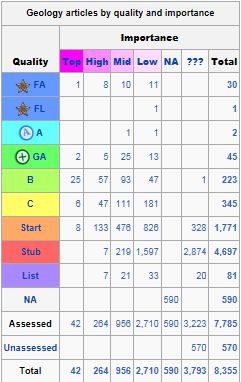
Becoming a Wikipedia editor can be daunting – the English site currently has nearly four million articles in all, and is expanding rapidly. To simplify things, the pages are organised into ‘projects’, with editors volunteering to join in with the projects which best fit their expertise. Projects can be general – there is a ‘geology project’, for example, or very specific subjects. Once a member, editors can get a better sense of what articles already exist, and which are in need of shaping up. They can also discuss any issues with other editors.
All Wikipedia articles are rated for the accuracy, neutrality, completeness and style. ‘Featured articles’ (FA) are those which have come out on top, after being rated by Wikipedia editors. After this, articles are graded from A to C, or classified as ‘start’ or ‘stub’ articles which need completing. It’s easy to access the articles listed in the table, or have a look at a project which is more specific to your expertise, such as palaeontology, volcanoes, dinosaurs, etc.
A quick look at the
geology project’s table shows that, whilst there are some excellent examples, there is still a lot of work to be done to improve geology’s presence on Wikipedia.
Like it or not, Wikipedia has become one of the first - and often only - resources people turn to in search of answers. And despite the occasional well publicised errors and hoaxes, the site's commitment to providing accessible and high quality information is the reason for its popularity. The more experts engage, the better the information will be, and without their input, others less qualified will fill the gap. The responsibility lies with those who know better to get there first.